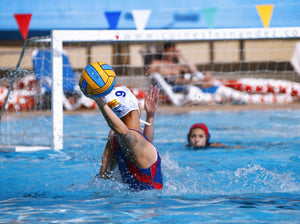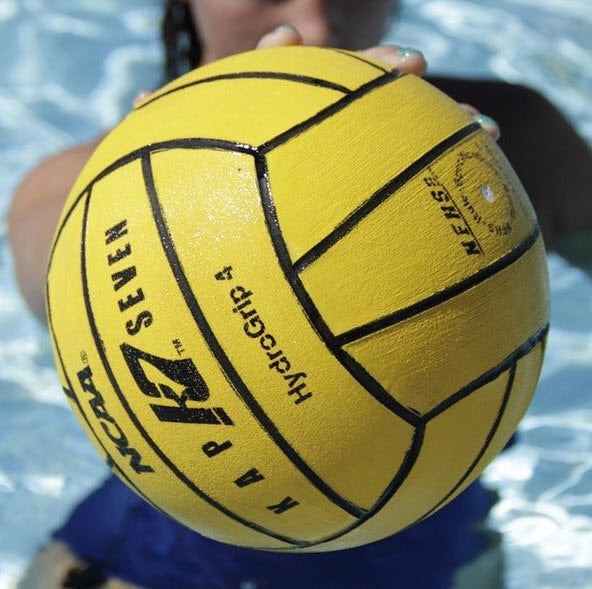History of Water Polo
Water polo may have a reputation as a brutal sport, but today’s game is genteel compared to its violent origins. In England, the game began as a water-based form of rugby during the mid-1800s. It was played indoors and outdoors, in lakes and ponds.
In 1870 the London Swimming Association created rules for the indoor version of the sport, which stated, among other things, that a goal was scored when a player used two hands to tag the far wall with the ball. The rules also allowed goalies to stand on the side of the pool and jump onto players advancing underwater with the ball. Outright violence, injuries, and near-drownings were part of the game.
Scottish Passing Game Changes the Sport
The Scotts revolutionized water polo. They were the first to use a cage goal, and played a game that bore more resemblance to soccer than rugby. They used a larger ball and placed a new emphasis on passing. In 1889, Hungary became the first country to adopt the more civilized Scottish rules. Other European countries soon followed suit: Austria and Germany in 1894, France in 1895, and Belgium in 1900. Meanwhile in the United States, water polo, which also began in the late 1880s, was flourishing in the more violent format.
Water Polo Becomes the First Olympic Team Sport
In 1900, water polo became the first team sport contested in the modern Olympic Games. It was only a men’s sport at the time, largely because of the game’s inherent violence. The United States’ preference for the more violent rules of play kept European teams from participating in the 1904 Olympic Games, which were held in the United States.
Although records show that the first women’s water polo game was played in Holland in 1906, the women’s game did not gain broad popularity until nearly one hundred years later. The United States held a national tournament in 1926, but the sport was considered too brutal for women and was largely abandoned until the 1960s.
Rule Changes Speed Up Play, Alter Nature of the Game
In 1928 a Hungarian coach developed the “dry pass,” forever changing the dynamics of play and simultaneously creating a Hungarian water polo dynasty that would last for sixty years. The new emphasis on passing forced European players to develop finesse and skill, as brute force alone was no longer enough to win a game.
FINA became the official rule-making body for water polo in 1930, in part to arbitrate the different sets of rules that had emerged in Europe and the United States. This brought change to the last few US clubs still playing under the more violent American rules. (Most US clubs had adopted the European rules by 1914.)
Subsequent rule changes also helped transform the nature of the sport. In 1949 game play sped up dramatically when a rule change allowed play to continue after an ordinary foul. In the 1970s the shot clock was introduced. Teams were given forty-five seconds to attempt a goal, and if they failed to do so, the ball was given to the opposing team. Most rules today have further reduced the shot clock to thirty or thirty-five seconds.
Violence Returns to Olympic Water Polo
Violence returned to the sport dramatically, in the most infamous water polo game in history: the 1956 Olympic match between the USSR and Hungary. Fueled by external political tension between the two countries (the Soviet army had tamped out the Hungarian Revolution against the Soviet’s occupying government only days prior to the match), the Olympic semi-final game started with verbal taunts and became extraordinarily violent.
After a Hungarian player was punched in the face and the crowd was nearly rioting, the referees, fearing for everyone’s safety, ended the game a minute before the clock was to run out. Hungary, which had been leading 4-0, was declared the winner and advanced in the tournament. They went on to win the gold medal.
Hungary’s win that year was dramatic, but not necessarily a surprise to the world. Hungary had dominated Olympic water polo prior to that Olympiad, and would continue to be a powerful team for another twenty years. Of the ten possible Olympic gold medals between 1932 and 1976, Hungary won six.
Women’s Water Polo
Following the 1960s, women’s water polo quickly became popular. Today it is played in many American high schools and is often said to be just as, if not more, brutal than the men’s game. (Although, the rules are essentially the same.) The first FINA World Cup for Women was held in 1979 and won by the United States. In 2000, women’s water polo became an Olympic sport, after its turn as a demonstration sport in the 1996 Atlanta Games.



